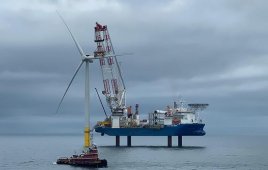In July 2011, the Federal Energy Regulatory Commission (FERC) issued Order No. 1000 on transmission planning and cost allocations. The reforms in Order 1000 should lead to more transmission investment, especially in transmission projects intended to move renewable energy resources onto the grid.
To understand the challenges ahead, first consider what FERC is trying to “fix.” The Commission concluded that the lack of a requirement for transmission providers to consider transmission needs at the local or regional level driven by public policy requirements—such as clean energy requirements—made its existing transmission planning requirements inadequate. In remarks about the rule, FERC Chairman Jon Wellinghoff recognized a changing mix of generation resources seeking to use the transmission system. In fact, even the Open Access Transmission Tariffs (OATTs) for centralized markets in certain states with RPS standards, ISO-New England and PJM for example, do not yet specifically provide for public policy-driven transmission projects. FERC also concluded that there were few existing procedures for identifying and evaluating the benefits of interregional transmission projects. The rule also eliminated the right of first refusal (ROFR) in OATTs under certain circumstances. In certain regions, independent developers have attributed difficulties constructing certain types of transmission projects to ROFRs granted to incumbent transmission providers.
Order 1000 requires transmission providers to revise their OATTs to include a process for identifying transmission needs driven by public policy requirements, and for evaluating possible solutions. Order 1000 does not mandate that transmission be built for public policy purposes.
Also, transmission providers’ OATTs will now include a process to allocate the costs for such a project. The rule establishes guiding cost-allocation principles consistent for all regions with the central concept being “beneficiary pays.” One such principle is that an acceptable cost allocation proposal would allocate costs for new transmission facilities in a manner that is at least “roughly commensurate” with the benefit received by those who will pay these costs. Consistently, the principles also provide that entities that receive no benefits from transmission projects should not be allocated costs for those facilities. FERC’s principles for regional and interregional cost allocation do not mandate how beneficiaries are to be identified or which cost-allocation methods should be implemented. A transmission provider could rely on the same cost allocation for market efficiency, reliability, and public policy transmission projects.
Order 1000 is not a fill-in-the-blank rule, so its implementation will be intense and contentious. Submittals on regional transmission projects are due to FERC by October 11, 2012.Order 1000 noted that FERC is not seeking to undermine progress already underway or already accomplished. Those centralized markets (ISOs or RTOs) with transmission planning procedures in place that take public policy objectives into account will likely have the smoothest compliance, and their existing methods will likely continue. For example, Midwest ISO (MISO), Southwest Power Pool (SPP), and California ISO (CAISO) have provisions to consider public-policy projects, including cost allocation provisions, and may not have to make significant revision to their OATTs. Thus, MISO, SPP, and CAISO may implement the rule’s requirements quicker.
For regions outside an ISO or RTO, the first step, identifying a region, may be challenging. In addition, transmission providers outside centralized markets will need to propose how they will allocate project costs within the region, once it is identified. In areas of the country where there are no RPS requirements, FERC might accept a less detailed plan for considering public policy driven processes.
Compliance submittals do not immediately become effective upon filing with FERC, and proposed tariff changes must be accepted for filing by FERC order. The Commission has stated that if stakeholders cannot reach consensus or near consensus during a compliance period, the FERC will resolve compliance issues. This may incent compromise. There is a real opportunity for states to lead the way among stakeholders on consensus proposals.
Transmission providers must return to FERC with their interregional plans by April 11, 2013. As to interregional efforts, best practice is for transmission providers to proceed simultaneously with the interregional and regional efforts rather than wait to consider interregional plans until the October 2012 regional submittal has been made. Interregional issues may be particularly difficult outside of an ISO or RTO context. However, interregional transmission planning and cost allocation will likely be less formal than the regional process, possibly allowing transmission providers with more flexibility on the level of detail included in their FERC submittal.
FERC may issue a subsequent order(s) that modifies Order 1000. Therefore, in addition to the implementation hurtles that result from developing the compliance filings and FERC processing the compliance filings, there is a chance that FERC could clarify, modify, or even reverse some of its findings in Order 1000.
Over 60 entities, including transmission providers, transmission customers, state commissions and industry trade groups, have asked FERC to change course. Also, those who asked FERC to change course may appeal Order 1000 to the U.S. Court of Appeals asking the court to take action. However, a court decision on appeal of Order 1000 could be years away. In the interim, unless and until the FERC or a court decides to stay the effectiveness of Order 1000, the rule remains effective.
The combination of eliminating certain ROFRs, the mandate to consider public policy requirements, and the requirement for interregional planning should lead to increased opportunities for transmission investment, particularly for bringing location-constrained renewable resources onto the grid. Therefore, the long-term outlook for public policy-driven transmission projects is favorable. The shorter-term outlook is more challenging outside regions that have already made progress in this regard. It may be a long process before ISOs and other regions have effective cost allocation proposals for public policy projects in place. However, once the process is complete and cost-allocation methods are in place, additional certainty will likely spur investment in transmission. With a long lead-time for compliance filings and FERC consideration and approval, it may be more attractive in the shorter term for developers to consider merchant or participant-funded transmission projects to the extent that defined cost allocation rules are not already in place. WPE
 By: Cathy McCarthy, Co-head of Dewey & LeBoeuf’s Energy Regulatory Department www.deweyleboeuf.com
By: Cathy McCarthy, Co-head of Dewey & LeBoeuf’s Energy Regulatory Department www.deweyleboeuf.com
Filed Under: Policy




